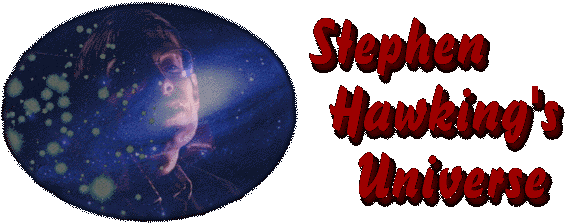 | ||
| PROGRAMME
5, "BLACK HOLES AND BEYOND" UK Air Date (BBC 2): September 28th at 7.45pm, US Airdate (PBS): November 10th at 9pm | ||

The invention of radio astronomy over 50 years ago opened new horizons for astronomers. It led to SETI - the Search for Extra-Terrestrial Intelligence - looking for stray alien communications. And it also led to astronomical discoveries. Among these were quasars, discovered in 1963 - bizarre objects billions of light years away, the same size as our solar system, with a power output greater than all of the stars in our galaxy put together. No-one could explain what could cause these quasars. But in the equations of Albert Einstein's General Theory of Relativity, which described the behaviour of the large scale Universe, was a possible explanation, arising out of what happened to a star when its fuel ran out, and it collapsed under its own gravity. In 1939 the American physicist Robert Oppenheimer had suggested that when that happened, a star might collapse so far that not even light could escape from it - it would cut itself off from the universe. Einstein disagreed. He thought that you could only squeeze matter so far. But this argument was interrupted by the second world war, and then the development of the atom bomb and the H-bomb, which absorbed the work of many physicists. But quasars re-awoke the debate. A physicist called John Wheeler led the call for 'gravitationally completely collapsed objects' to be considered as real objects, since the huge energies their gravitational fields would generate might explain quasars. He came up with a new name for them - black holes. Computer simulations, based on codes developed to calculate how an H-bomb worked, seemed to support the idea that a star could collapse to form a black hole. Thanks to John Wheeler's name, 'black holes', the idea captured the imagination of science fiction writers and the general public. Scientists postulated giant black holes at the centre of galaxies, even our own. But what people really wanted to know was - what happened to the matter that fell into a black hole. The mathematician Roger Penrose, encouraged by Stephen Hawking's tutor, Dennis Sciama, proved that matter in a black hole would be crushed into a single point of infinite density, where the laws of physics as we know them seem to break down - a crisis for twentieth century theoretical physics. Hawking proved that this point was equivalent to the point at the start of the universe- the Big Bang. If we could understand black holes, maybe we could understand the moment of creation. Hawking made an insurance bet with one of John Wheeler's students, that black holes would not exist - so that if his life's work turned out to be wasted, at least he would have some recompense. Astronomers began to search for black holes. A Russian physicist, Yakov Zeldovich, had realised that if two stars are orbiting each other and one becomes a black holes, then the remaining star will seem to orbit nothing. By the speed of the orbiting star, scientists can work out how big the invisible object could be. Several objects have been fond which seem to satisfy this description - so much so, that Stephen Hawking is convinced and has settled his bet. And if galactic sized black holes do exist, they explain quasars - they shine incredibly brightly as matter is sucked into a black hole and heats up due to friction. The science of black holes has thrown up some bizarre possibilities, since physics as we know it breaks down inside black holes. The mathematics seems to allow instant travel millions of miles across space, or even time travel. Whatever is really true, black hole are a lesson to scientists - never to ignore their imaginations when thinking about what our universe is really like.  | ||
|